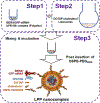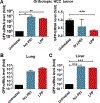Lipidation of polyethylenimine-based polyplex increases serum stability of bioengineered RNAi agents and offers more consistent tumoral gene knockdown in vivo
- PMID: 29894758
- PMCID: PMC6388695
- DOI: 10.1016/j.ijpharm.2018.06.026
Lipidation of polyethylenimine-based polyplex increases serum stability of bioengineered RNAi agents and offers more consistent tumoral gene knockdown in vivo
Abstract
Recently we have established a novel approach to produce bioengineered noncoding RNA agents (BERAs) in living cells that carry target RNAi molecules (e.g., siRNA and miRNA) and thus act as "prodrugs". Using GFP-siRNA-loaded BERA (BERA/GFP-siRNA) as a model molecule, this study was to define the in vitro and in vivo knockdown efficiency of BERAs delivered by liposome-polyethylenimine nanocomplex (lipopolyplex or LPP). Compared to in vivo-jetPEI® (IVJ-PEI) and polyplex formulations, LPP offered greater protection of BERA/GFP-siRNA against degradation by serum RNases. Particle sizes and zeta potentials of LPP nanocomplex remained stable over 28 days when stored at 4 °C. Furthermore, comparable levels of BERA/GFP-siRNA were delivered by LPP and IVJ-PEI to luciferase/GFP-expressing human SK-Hep1-Luc-GFP or A549-Luc-GFP cells, which were selectively processed into target GFP-siRNA and subsequently knocked down GFP mRNA and protein levels. In addition, LPP-carried BERA/GFP-siRNA was successfully delivered into xenograft tumors and offered more consistent knockdown of tumoral GFP mRNA level in an orthotopic hepatocellular carcinoma (HCC) SK-Hep1-Luc-GFP xenograft mouse model, while IVJ-PEI formulation showed larger variation. These findings demonstrated that lipidation of polyplexes improved serum stability of biologic RNAi molecules, which was efficiently delivered to orthotopic HCC tissues to knock down target gene expression.
Keywords: Bioengineering; Cancer; Lipopolyplex; Mouse model; Orthotopic HCC; RNA delivery; siRNA.
Copyright © 2018 Elsevier B.V. All rights reserved.
Figures





Similar articles
-
Optimized polyethylenimine (PEI)-based nanoparticles for siRNA delivery, analyzed in vitro and in an ex vivo tumor tissue slice culture model.Drug Deliv Transl Res. 2017 Apr;7(2):206-216. doi: 10.1007/s13346-016-0306-y. Drug Deliv Transl Res. 2017. PMID: 27334279
-
Superparamagnetic iron oxide nanoparticles modified with polyethylenimine and galactose for siRNA targeted delivery in hepatocellular carcinoma therapy.Int J Nanomedicine. 2018 Mar 26;13:1851-1865. doi: 10.2147/IJN.S155537. eCollection 2018. Int J Nanomedicine. 2018. PMID: 29618926 Free PMC article.
-
Polo-like Kinase 1-targeting Chitosan Nanoparticles Suppress the Progression of Hepatocellular Carcinoma.Anticancer Agents Med Chem. 2017;17(7):948-954. doi: 10.2174/1871520616666160926111911. Anticancer Agents Med Chem. 2017. PMID: 27671301
-
Nanoparticles for targeted delivery of therapeutics and small interfering RNAs in hepatocellular carcinoma.World J Gastroenterol. 2015 Nov 14;21(42):12022-41. doi: 10.3748/wjg.v21.i42.12022. World J Gastroenterol. 2015. PMID: 26576089 Free PMC article. Review.
-
Small interfering RNA-mediated gene suppression as a therapeutic intervention in hepatocellular carcinoma.J Cell Physiol. 2019 Apr;234(4):3263-3276. doi: 10.1002/jcp.27015. Epub 2018 Oct 26. J Cell Physiol. 2019. PMID: 30362510 Review.
Cited by
-
RNAi-Based Therapeutics and Novel RNA Bioengineering Technologies.J Pharmacol Exp Ther. 2023 Jan;384(1):133-154. doi: 10.1124/jpet.122.001234. Epub 2022 Jun 9. J Pharmacol Exp Ther. 2023. PMID: 35680378 Free PMC article. Review.
-
RNA therapy: Are we using the right molecules?Pharmacol Ther. 2019 Apr;196:91-104. doi: 10.1016/j.pharmthera.2018.11.011. Epub 2018 Dec 4. Pharmacol Ther. 2019. PMID: 30521885 Free PMC article. Review.
-
Innovations in Biomaterial Design toward Successful RNA Interference Therapy for Cancer Treatment.Adv Healthc Mater. 2021 Jul;10(13):e2100350. doi: 10.1002/adhm.202100350. Epub 2021 May 11. Adv Healthc Mater. 2021. PMID: 33973393 Free PMC article. Review.
-
Preparation and Preliminary Evaluation of Dual-functional Nanoparticles for MRI and siRNA Delivery.Iran J Pharm Res. 2021 Fall;20(4):265-277. doi: 10.22037/ijpr.2021.115099.15219. Iran J Pharm Res. 2021. PMID: 35194445 Free PMC article.
-
RNA Drugs and RNA Targets for Small Molecules: Principles, Progress, and Challenges.Pharmacol Rev. 2020 Oct;72(4):862-898. doi: 10.1124/pr.120.019554. Pharmacol Rev. 2020. PMID: 32929000 Free PMC article.
References
MeSH terms
Substances
Grants and funding
LinkOut - more resources
Full Text Sources
Other Literature Sources
Medical

